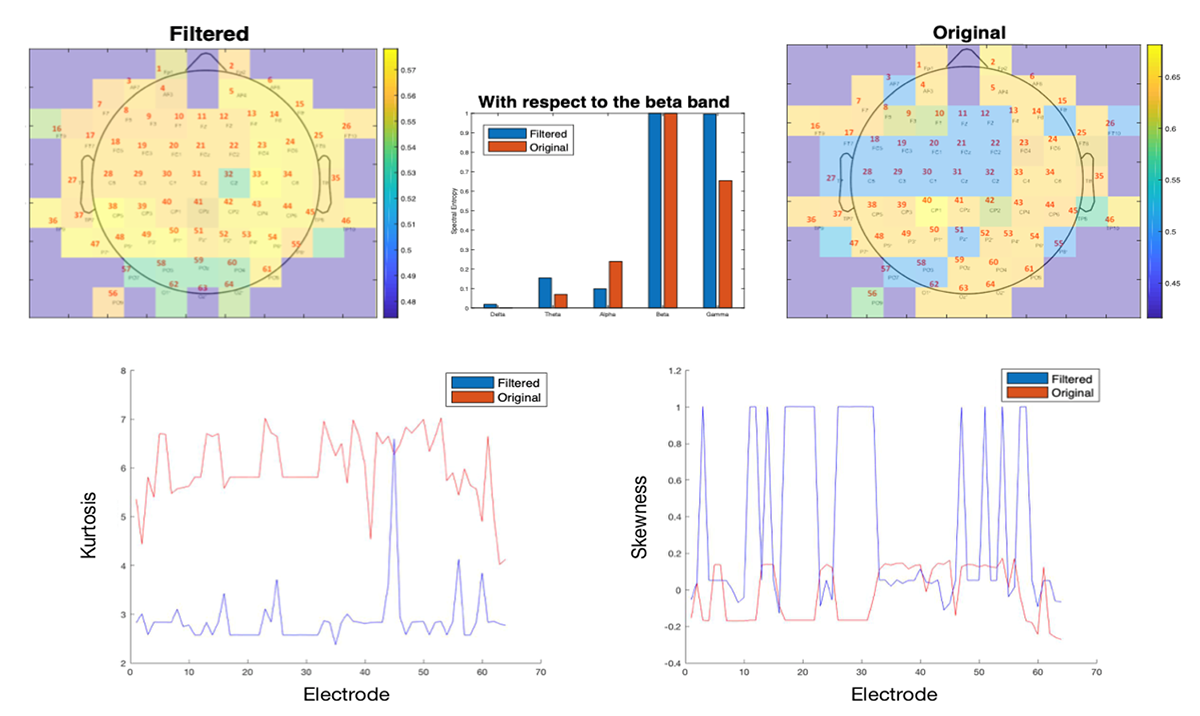Session Information
Date: Tuesday, September 24, 2019
Session Title: Parkinsonisms and Parkinson-Plus
Session Time: 1:45pm-3:15pm
Location: Agora 3 West, Level 3
Objective: The aim of this study is the analyisis of the influence of various spatial filtering procedures (reference election) on a collection of signals stochasticisty measurements of EEG recordings, including different estimators of brain entropy, an non-linearity properties.
Background: Parkinson’s Disease is a degenerative neural disorder involving both motor and congitive dysfunctions, as the result of the progressive loss of dopaminergic neurons, so that the brain connectivity patterns are supossed to be deeply modified [1-2]. Electroencepalography is a noninvasive techince widely used in neuroscience as a real-time brain function probe. From the pool of statistical proporties of EEG recordings, those related with the signal stochasticisty are frequently associated to the brain information processing, in such a way that their patterns have become usual targets in the developement of brain disorders biomarkers. However tens of statistical properties, not necessarily related, can be used in order to describe the “brain entropy”. Furthermore, these porperties are usually strongly dependent on the chosen EEG reference and montage [3-5]. This scenario causes confusion regarding the relationship between the meaning of these properties, and their relationship with the brain conectivity and information processing alterations.
Method: Sixty-four channel EEG were recorded from a group of Parkinson’s Disease patients, paried with a equivalent control group. EEG signals artifacts were cleaned by using standard Matlab EEGLab platform. Statistical properties of EEG signals were calculated through Matlab and Mathematica libraries.
Results: Preliminary results show that any alteration in the EEG signal will produce an alteration in the statistical parameters, being modified those associated to the average of all the electrodes, and those associated to each electrode individually, and therefore to its topological location.
Conclusion: Both brain connectivity and entropy patterns obtained from EEG recordings are strongly dependent on the spatial filtering method. Therefore, this should lead to caution when interpreting these patterns as signs of disease.
References: [1] Olde Dubbelink KT1, Stoffers D, Deijen JB, Twisk JW, Stam CJ, Berendse HW. (2013) Cognitive decline in Parkinson’s disease is associated with slowing of resting-state brain activity: a longitudinal study. Neurobiol Aging, 2013, 34, 408 [2] Bertrand J.A., McIntosh A. R., Postuma R.B., Kovacevic N., Latreille V., Panisset M., Chouinard S., Gagnon J. F., (2016) Brain Connectivity Alterations Are Associated with the Development of Dementia in Parkinson’s Disease, 2016, 6, 216 [3] Chella, F., Pizzella, V., Zappasodi, F. , Marzzetti, L. (2016). Imapct of the reference choice on Scalp EEG conectivity estimation. Journal of Neural Engineering, 2016, 13, 036016 [4] Trambaiolli, L.R., Lorena, A. C., Fraga, F. J., Kanda, P.A.M.K, Nitrini, R. and Anghiniah R. (2011) Does EEG Montage Influence Alzheimer’s Disease Electroclinig Diagnosis? International Journal of Alzheimer’s Disease, 2011, 761891 [5] Xu Lei, and Keren Liao (2017) Understanding the Influences of EEG Reference: A Large-Scale Brain Network Perspective, Frontiers in Neuroscience, 11, 205.
To cite this abstract in AMA style:
D. Herraez-Aguilar, A. Maitín, R.. Perezzan, D. Del Castillo, I. Serrano, E. Rodríguez, E. Rocon, A. Arroyo, J. Andreo, J. Romero. Influence of spatial filtering on EEG signal stochasticity measurements in Parkinson’s Disease [abstract]. Mov Disord. 2019; 34 (suppl 2). https://www.mdsabstracts.org/abstract/influence-of-spatial-filtering-on-eeg-signal-stochasticity-measurements-in-parkinsons-disease/. Accessed January 2, 2026.« Back to 2019 International Congress
MDS Abstracts - https://www.mdsabstracts.org/abstract/influence-of-spatial-filtering-on-eeg-signal-stochasticity-measurements-in-parkinsons-disease/

